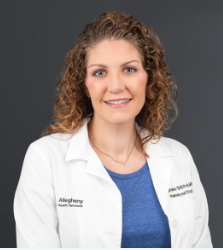AHN Multidisciplinary Team Successfully Transforming Interstitial Lung Disease
AHN's AI-ILD clinic provides collaborative care, uniting pulmonology and rheumatology specialists for efficient treatment of ILD.
Brianna DiSilvio, MD
Credit: Allegheny Health Network

Interstitial lung disease (ILD) is a diagnosis that challenges even the most seasoned healthcare professionals. With more than 200 lung disorders that fall under the ILD classification, they all involve inflammation, fibrosis, and relentless respiratory compromise.
Its stealthy progression and numerous manifestations require specialists to effectively manage the disease. The AHN Autoimmune Interstitial Lung Disease (AI-ILD) clinic breaks down barriers to care for patients with a multidisciplinary one-stop approach. It unites rheumatology and pulmonology to provide patients with tailored care quickly and efficiently.
“Collaborative care for ILD patients is hard to provide when this complex disease is being managed by two separate providers who may not be on the same page,” said Briana DiSilvio, MD, Pulmonary and Critical Care specialist. “Pulmonology and Rheumatology visits may be scheduled months apart for patients, resulting in communication challenges and interruption in treatment decisions.”
Dr. DiSilvio works side-by-side at the clinic with Joanna Marco, MD, AHN rheumatologist. Combined visits allow the team to get patients on the right track for therapy more quickly. In the traditional model of siloed subspecialty care, patients may spend six months to a year playing catch up with their providers, waiting for a cohesive management plan to be decided upon. That delay is effectively eliminated at the AI-ILD clinic, where treatment success along with shortcomings in therapy regimens are recognized earlier, and opportunities for medication alteration can happen sooner.
“If a patient says they’re having trouble walking up the stairs, Dr. DiSilvio and I are together figuring out if it’s because their lungs are acting up, or their arthritis, or their muscle disease is bad,” Dr. Marco explained. “Together in real time, we’re discussing workup and treatment options, and this is a huge benefit to our patients.”
Breaking down the disease
The common link between the many forms of ILD is inflammation in the interstitium – the scaffolding that supports the lungs’ structure. These diseases inflame or scar the lungs, causing pulmonary fibrosis and destroying the air sacs.
Symptoms are different for each patient and may look like other lung conditions or health problems. But the most common red flags that warrant a specialist visit include persistent and progressive dyspnea, particularly in the absence of an obvious etiology; unexplained cough; bibasilar crackles on auscultation, or radiographic abnormalities on chest imaging.
As gatekeepers of patient care, primary care physicians play a pivotal role recognizing the telltale signs of ILD and facilitating timely referral to specialized care, Dr. DiSilvio said.
“Our referring colleagues are our partners in helping patients grappling with this challenging condition, Dr. DiSilvio said. “We’re grateful we can work together to alleviate the burden of the disease and empower our patients to start on a path of healing.”
Nurturing Hope in the Face of Challenge
While a cure for ILD remains elusive, treatment goals focus on mitigating symptoms, halting disease progression, and improving quality of life.
Pharmacological interventions, including corticosteroids, immunosuppressants, and antifibrotic agents, are the main options for medical management. Supplemental oxygen therapy plays a pivotal role in alleviating hypoxemia and enhancing patient comfort.
Also, pulmonary rehabilitation offers a holistic approach to symptom management through exercise training, education, and psychosocial support.
Strength in unity
As part of the AHN Autoimmunity Institute, the Autoimmune ILD clinic works closely with the nurses, mental health staff, and pharmacists at the institute. Dr. Marco said blending rheumatology and pulmonary to care for these patients has led to improved communication and shared decision making.
“Dr. DiSilvio and I each have to show humility and listen to one another’s opinions,” Dr. Marco said. A patient’s joint disease may be well-controlled, but their lung disease is not. Or maybe they’re doing well from a respiratory standpoint, but they have muscle pain and skin rashes. It’s a give and take. We come together, each with our own expertise, but we know when to defer to the other to take the lead on a patient’s care, and vice versa.”
The Autoimmune ILD clinic has had extremely positive patient satisfaction results. Patients say visiting their doctors at one location, at one time, has reduced the stress and physical impact they previously felt with multiple office visits.
“Going back and forth between providers and waiting for treatment decisions to be made – all of that is an emotional burden on patients,” Dr. DiSilvio said. “We really work to eliminate that and to let patients know we’re on the same team.
To get more information or to refer a patient, call 412-578-3511.